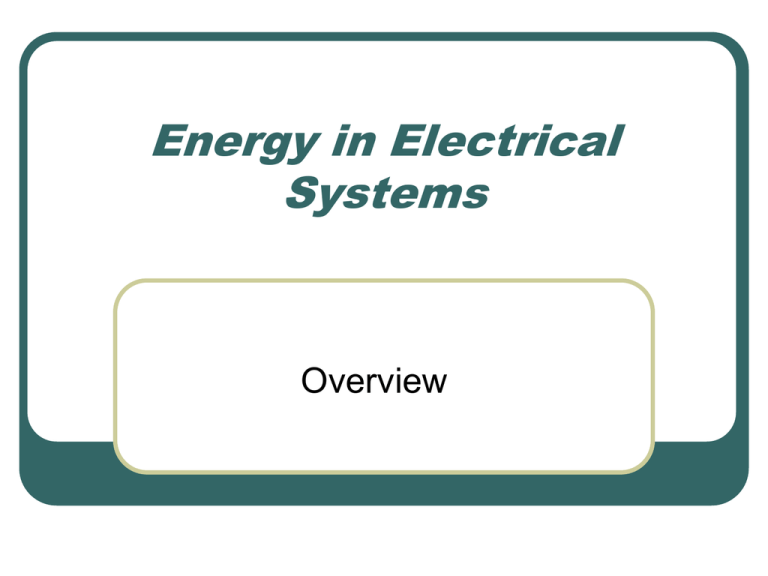Energy in Electrical Systems
advertisement

Energy in Electrical Systems Overview How can Potential Energy be stored in electrical systems? Battery • Stored as chemical energy then transformed to electrical energy on usage Water behind a dam • Water drives a turbine that generates electrical energy Capacitor • Stores electrical energy as PE Inductor • Stores electrical energy as PE What is a capacitor? An electrical device that separates and stores electric charge (q) Characteristics • Capacitors oppose voltage changes • Capacitors smooth out voltage changes How are capacitors made? General • A capacitor has 2 large plates of conducting material separated by an insulating layer, called the dialectric. Shape • • Usually rolled into a cylinder, or Variable capacitor (tuners in radios) • The more the plates mesh the higher the capacitance Examples - Schematic Work and a Capacitor Work is done to separate the + and charges on the capacitor plates • = charging the capacitor Work is stored as potential energy in the capacitor As the charge increases, the voltage across the capacitor increases Units of Capacitance (English & Metric) Capacitance is a quantity that reflects the ratio of net charge stored to the voltage difference across the plates. • C = q/V 1 Farad (F) = 1 coulomb/1 volt (a very large value) Typical values • • Microfarads (x 10-6, F) Picofarads (x 10-12, pF) How much energy can be stored in a capacitor? Ep = ½ CV2, where Compare with the amount of energy in a stretched spring • Ep = stored electrical potential energy (J) • C = capacitance (Farads) • V = voltage (volts) • Ep = ½ kd2 Capacitance characteristics Capacitance is determined by • Area of the plates • Gap between the plates • Type of insulating material between the plates Example A single-phase 240 V motor has a capacitor in its starting unit, rated at 50 F (50 x 10-6F). Find • The charge stored on the plates • The potential energy stored in the capacitor Solution C = q/V, so Ep = ½ CV2, so • q = CV • q = 50 x 10-6 x 240 • q = 0.012C (coulombs) • Ep = ½ x 50 x 10-6 x 2402 • Ep = 1.44 J (joule = coulomb/volt) What is an inductor? An electrical device used in circuits to oppose changes in current. (not a resistor that opposes current) • Current change manager Acts likes a flywheel to smooth out current changes. • Called chokes, filters or coils An Inductor An inductor builds up voltage in itself to help overcome the circuit voltage that is causing the current to change. • • If the circuit voltage increases, the inductor builds a voltage in the opposite direction. If the circuit voltage decreases, the inductor adds voltage to the circuit to help keep the current from increasing. How are inductors made? An inductor is basically a coil of wire, that may or may not have a core (usually iron) The inductance of an inductor with an iron core is much higher than an inductor with an air-core. Variable inductors allow the core to be moved in or out of the coil. Units of Inductance (L) An inductor is rated on how much voltage it can develop to oppose a certain rate of change in current Units = Henries (L) • 1 henry inductor will develop 1 volt whenever • • the current is changing at 1 amp/second 1 henry = 1 volt/(1 amp/sec), or 1 henry = 1 ohm-second Energy calculations for inductors? The potential energy stored in an inductor (Ep) is • Ep = ½ LI2, where • Ep = energy in joules • L = inductance in henries • I = current in amps Compare with the capacitor • Ep = ½ CV2 Example An inductor has an inductance of 8 henries and a resistance of 2 ohms. The inductor is connected to a 30V DC steady power source. Find • The energy stored by the inductor Solution Find I Find Ep • I = V/R (Ohm’s law) • I = 30/2 = 15 amps • Ep = ½ LI2 • Ep = ½ x 8 x 152 • Ep = 900 J How are work and electrical energy related? Capacitor • Work is done when voltage charges a capacitor by moving the charge from one plate to the other. This work is the Ep. Inductor • Work is done when a voltage pushes a charge through an inductor – this work is Ep Electrical work W = charge moved x voltage difference • W=qxV Workplace applications for caps and inductors Auto ignition Electronic filter circuits Helpers for large electric motors


